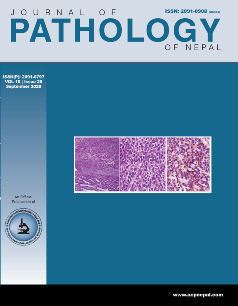Utility of fine needle aspiration cytology in head and neck lesions and its correlation with histopathology- a study in tertiary care hospital
DOI:
https://doi.org/10.3126/jpn.v10i2.30255Keywords:
Fine Needle Aspiration Cytology; Head and neck lesions; ThyroidAbstract
Background: Fine Needle Aspiration Cytology has rapidly gained acceptance due to the easy accessibility of target sites and minimally invasive nature. It is a very simple, quick, cost-effective method of sampling alternative to the time consuming complicated and invasive excision biopsy. The study aimed to access the utility of fine needle aspiration cytology in the diagnosis of various head and neck lesions and also to establish the diagnostic accuracy between the cytological and histopathological diagnosis.
Materials and Methods: A retrospective observational study of 380 cases of FNACs on head and neck swellings performed in various age groups in the Department of Pathology of a tertiary care hospital from January 2018 to December 2019.
Results: Out of 380 patients, the maximum number of cases were seen in the thyroid (40.8%), followed by lymph nodes (39.5%), skin, soft tissue, miscellaneous (10.8%) and salivary glands (8.9%). Benign and non-neoplastic cases outnumbered (88.1%) the malignant (10.8%) cases. Histopathological follow-up was available in 28 (7.4%) cases among which 25 (89.3%) cases were consistent with the cytodiagnosis. The sensitivity, specificity, and diagnostic accuracy were evaluated to be 80%, 94.4%, and 89.3% respectively.
Conclusions: The majority of the cases of head and neck swellings were seen in the thyroid followed by lymph nodes, skin, soft tissue, miscellaneous, and salivary glands. In thyroid, colloid goiter and papillary carcinoma were the commonest benign and malignant lesions respectively. In the lymph node, reactive lymphadenitis, and metastatic squamous cell carcinoma were the commonest benign and malignant lesions respectively.
Downloads
Downloads
Published
How to Cite
Issue
Section
License
This license enables reusers to distribute, remix, adapt, and build upon the material in any medium or format, so long as attribution is given to the creator. The license allows for commercial use.




